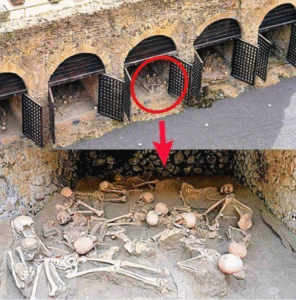☘️ Unveiling the Past: Herculaneum’s Ancient Beach Reopens to Visitors 🌋
High above the Bay of Naples, overshadowed by the legendary bulk of Mount Vesuvius, lies the archaeological site of Herculaneum, a seaside Roman town frozen in time by the eruption of 79 AD. Once buried beneath layers of volcanic flows and ash, much of its modern story has focused on frescoes, villas, wooden structures preserved by extraordinary conditions, and the tragic tales of the eruption’s victims. But for centuries, one part of its coastline, its ancient beach, remained off-limits, obscured by damage, water, decay, and the relentless passage of time.
That changed in mid-2024. After years of dedicated archaeological excavation, historic preservation, hydrological engineering, and restoration, the ancient beach of Herculaneum has finally reopened to the public. Visitors can now walk along the footpath across what once was the sandy shore where hundreds of people made their last stand, seeking rescue by sea. This reopening is more than just a tourist draw—it is a profound act of remembrance, research, and restoration.
A Shore Lost, Then Rediscovered
When Vesuvius erupted two millennia ago, Herculaneum and its inhabitants were caught in the pyroclastic flows and ashfalls that swept across the coast. Many fled to the seafront, clinging to the hope of rescue by boats or naval forces under the command of Pliny the Elder. Some sheltered in boat houses. Others stayed on the beach itself, hoping for an escape that never came. It is estimated that over 300 people perished in that area—men, women, children, even animals—seeking safety from the disaster. NPR+3Smithsonian Magazine+3The Washington Post+3
The beach, after centuries of burying under volcanic debris, remained inaccessible. Over time, it was flooded, turned marshy, silting up and becoming a shadow of what it once was. Access was limited, and much of its features degraded. Visitors could see way stations, boat sheds, some skeletal remains, and glimpses of shoreline architecture—but not the full stretch of shore as it once was. The Washington Post+2The Guardian+2
The Long Road to Restoration
The reopening follows a multi-year restoration project, initiated by the Italian Ministry of Culture along with the archaeological park’s leadership and support from entities like the Packard Humanities Institute. Efforts included:
-
Excavation and research: scientists worked to uncover the original levels of sand, identify remains, understand the path of the pyroclastic flows, and map how the ancient shore related to the city’s layout. Smithsonian Magazine+2The Guardian+2
-
Hydrological interventions: drainage systems and water controls were restored or improved to prevent flooding and marsh-formation, including reactivating ancient sewers and managing groundwater and runoff. Finestre sull’Arte+2Hawaii Public Radio+2
-
Structural and accessibility works: walkways were created, the area filled appropriately, the original surface levels reinstated (with material similar in appearance to ancient volcanic sand), while also making sure access is safe, including for wheelchair users. Smithsonian Magazine+2The Washington Post+2
The project aimed not only to conserve and protect, but to allow a powerful experiential link: letting visitors see the site “from the same position” as those ancient Romans might have — down through a tunnel or path to the beach itself, rather than viewing from above or from afar. The Washington Post+2Smithsonian Magazine+2
The Beach Reopens: What Visitors Will See
Since June 19, 2024, the beach has been fully open. Key features include:
-
A walkable expanse of the ancient beach, restored in both level and appearance (though with some modifications for safety and accessibility). Instead of loose volcanic black sand, a similarly colored material was used where needed, both for preservation and to allow mobility for all visitors. Smithsonian Magazine+2The Washington Post+2
-
The boat houses, with their arched doors, where many sheltering victims were found. Skeletons were uncovered in the ’80s and ’90s in these structures, especially those of women, children, and animals, who seem to have stayed in the boat sheds while others remained on the open shore. The Guardian+2Smithsonian Magazine+2
-
Remains of the figure known as the “Last Fugitive,” discovered in 2021: a man in his mid-40s clutching a satchel of personal possessions, likely trying to escape toward the sea when death caught him just parking between shore and relief. Smithsonian Magazine+1
-
Views toward where the sea once lapped—now obscured by volcanic flows and shifted coastline—but the restored beach gives a sense, for the first time, of standing at the water’s edge of 79 AD. The Washington Post+2CNN+2
Significance Beyond Tourism
Reopening the beach isn’t only about seeing ruins. It touches on several layers of significance:
-
Memorial and human connection
This is a place of mourning as much as of wonder. For many of the victims, their final moments were spent here, waiting for rescue that never arrived. The site gives voice to those stories: to the children, to the animals, to the individuals who carried what they could, who sheltered under collapsing roofs, who stayed near boats that never came. Walking this shore is to share, however briefly, in their last hope. -
Archaeological and scientific insight
Much of what was uncovered in recent decades—including identification of remains, mapping of flow paths, layering of volcanic deposits—adds to our understanding of not just how Herculaneum was destroyed, but how people experienced it. Studies suggest many victims in boat sheds may have died of asphyxiation by toxic fumes rather than instant destruction. The beach and its structures provide real, tangible evidence of these conditions. Smithsonian Magazine+1 -
Preservation and cultural continuity
The restoration shows what’s possible when past, present, and future are bridged with care. Managing water, preventing decay, making ruins accessible safely—all this helps ensure that heritage isn’t simply dug out and left to crumble. -
Economic and social opportunity
Restored public access fuels cultural tourism. For the region of Campania, for the town of Ercolano, the reopening is a chance to draw visitors, generate revenue, educate, and strengthen local identity. Italy’s Minister of Culture has emphasized the site’s value not just archaeologically but as a driver of socio-economic development. CNN+2The Independent+2
Reflecting on the Past through the Present
Visiting the restored Herculaneum beach is an almost mystical experience. To descend through a passage, emerge onto what would have been the shoreline, and see the remains of structures meant for escape or refuge—it’s a confrontation with fragility, with time, and with human aspiration.
Francesco Sirano, director of the Herculaneum Archaeological Park, has said that the restoration doesn’t just let people see a site; it helps them feel something: the scale of the catastrophe, the suddenness with which volcanic material obliterated daily life, and the bravery borne from desperation.
The beach, restored, accessible, open, becomes more than a ruin—it is a touchstone. It reminds us of what the ancient Romans believed about rescue, about the sea, about nature’s power. And about what it means when worlds are submerged in an instant.
Practical Notes for Visitors
If you plan to see the beach yourself, here are a few things to keep in mind:
-
Where & how to get there: Herculaneum is in Ercolano, in the Campania region of southern Italy, not far from Naples. Trains and regional transport connect Naples to Ercolano efficiently. The archaeological park is well-signposted.
-
What to expect: You’ll walk through restored paths, including a tunnel or descent into the beach area. Be prepared for uneven surfaces, though much has been made accessible.
-
Best times: Early morning or later afternoon visits are likely less crowded. Summers can be hot; spring and fall are ideal.
-
Reflective mood: It’s more than a sightseeing spot. Wear comfortable shoes. Allow time to absorb the quiet and the gravity. Visit the nearby museum displays and learn about the discoveries (like the ringed lady, the last fugitive) to understand what you’re seeing.
A Moment of Resurrection
After nearly 2,000 years of silence, the shore that witnessed human hope, desperation, collapse, and burial is speaking again. The beach has come back not exactly as it was—but as much as we can ever hope to recover what was lost: the outline, the story, the presence.
In its reopening, Herculaneum’s ancient beach invites us not just to look, but to stand. To imagine the sea lapping at sand, the cries for rescue, the shadows of boat houses, the footsteps racing and then falling silent. It is an act of reclamation of memory, of history, and of human fragility—but also of human resilience.


